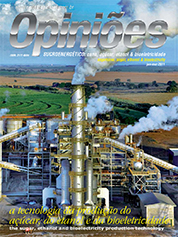Helgo Paul Hermann Ackermann
Director of Iprosucar Consultoria e Engenharia
Op-AA-27
Crystallization
The objective of crystallization essentially focuses on the production of saccharose crystals of certain sizes and uniformity. In practice, this objective is achieved to a greater or lesser degree of precision, depending on the adopted crystallization process. Crystallization used to be viewed as an art and there were not many distinguished operators to do this job.
Knowledge obtained by such operators over the years was not easily publicized. Technicians and engineers, with higher education and experience, lacked easy access to this art. Nowadays, crystallization follows scientific laws that are very well quantifiable and applicable. The crystallization process’ major importance lies in the quality of the produced sugar. Several procedures are nowadays used for that purpose:
- seeding with the slurry being carefully prepared and the crystallization done properly;
- use of vegetal vapor of the 2nd and 3rd evaporation effects, requiring higher capacity of the boiling pans, resulting in more uniform crystal sizes;
- use of stirrers, to achieve the better circulation of the massecuite in the boiling pan, which is advantageous for boiling of massecuites of lower purities;
- the remelt magma (or seed magma) boiling process when producing white sugar (< 140 Icumsa), mainly from juice extracted by diffusers.
Other technological innovations in the boiling house and centrifugation areas that are greatly beneficial to the crystallization operation in a mill;
- utilization of continuous crystallization in boiling pans, which can be classified as equipment already manufactured for that purpose and another that interconnects existing non continuous batch pans to a continuous crystallization in a horizontal cascade;
- utilization of high-efficiency condensers, with the advantage of reducing the volume of cooling water, by “setting” better approach of temperature, in addition to improving the system’s automation;
- washing sugar centrifuges with syrup wash layer (white run off), to reduce crystal losses and recirculation of sucrose in the process, resulting in process vapor savings;
- heating of centrifuge run off to dissolve the carried over fine crystals during the centrifugation of A massecuite, instead of dissolution with hot water, thereby avoiding introducing water into the process.
Some of the mentioned technologies will be described in more detail below: Magma remelt: one of the main difficulties in obtaining white sugar at color levels of less than 140 Icumsa, in mills using sugarcane diffusers for extraction, is the higher color content in the mixed juice.
This is due to the higher retention time, of about 50 to 60 minutes, at temperatures of 75 to 80ºC in the diffusers. The formation of color material is much higher than in plants using mills for extraction, especially when the sugarcane comes with a considerable amount of trash. On average, the mixed juice from the diffusers has color 30 to 35% higher than the juice mills.
On the other hand, due to the filter effect of the bagasse bed in the diffuser, the level of turbidity in juice from the diffusers is only a tenth that of a mill. For that reason, many years ago, the mud filters were eliminated in South Africa and other countries, with the mud returning directly to the diffuser.
To eliminate color, one recommends reducing color circulation and improving A sugar by remelting the magma, or “Seed Magma” process. This procedure, one of the most effective, is based on the total dissolution of B sugar with flotated thick juice and the formation of a grained massecuite in a separate boiling pan, which will be used as foot in boiling pans for the production of A massecuite.
“Seed magma” will be used to feed the A massecuite pans, replacing the current procedure that uses syrup and B sugar magma. Continuous Crystallization Scheme Cascade: The objective of this technology is to transform existing boiling pans in the mill into a continuous crystallization system in cascade, widely used in other countries.
The main advantage of this continuous crystallization system with stirrers, compared with the existing continuous pans available in the market - FCB, F&S and others that work without stirring – consists in linking existing batch pans to obtain a continuous system at lower costs. However, experience has shown that a well-dimensioned continuous cascade system, when used without stirrers, can be compared to conventional continuous boiling pans available in the market.
However, pans in cascade with stirrers have shown better results compared to those of conventional pans. Like in all continuous processes, through this transformation, one achieves better results and can optimize existing equipment, in addition to the uniform consumption of vapor and water in the condensation system.
Washing centrifuges with white run off: this washing system, widely used in Europe, consists of the combination of sugar washing with white run off in automatic centrifuges, followed by washing with water, whose major advantage is the considerable reduction of the volume of water in washing, from 10 to < 5% in relation to the volume of sugar produced. Another, no less important advantage, consists in the reduction in the dissolution of crystals (crystal losses) during centrifugation. Thus, the application of the washing system with white run off contributes to a considerable reduction in water consumption and the dissolution of crystals in centrifugation.




